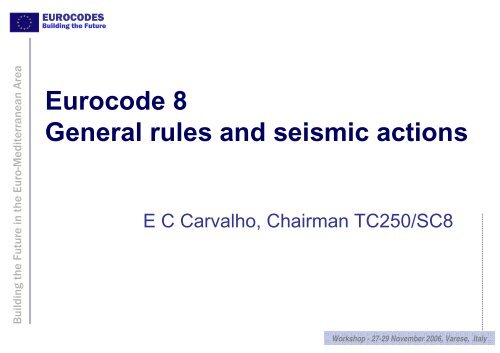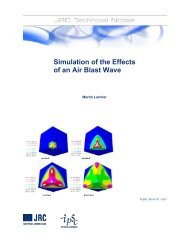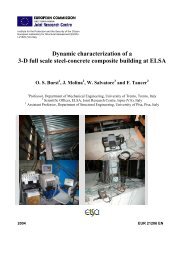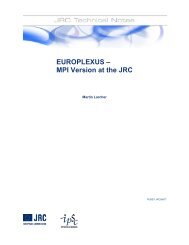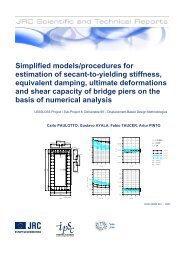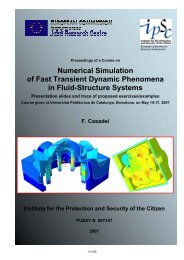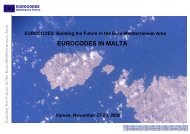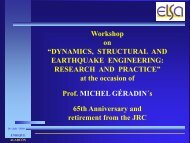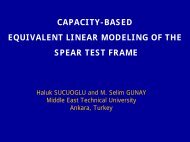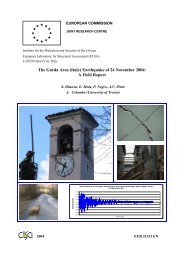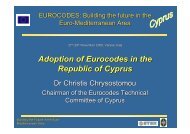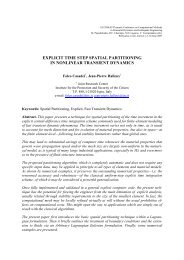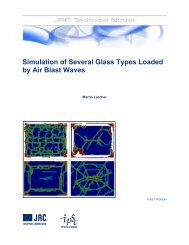Eurocode 8 General rules and seismic actions
Eurocode 8 General rules and seismic actions
Eurocode 8 General rules and seismic actions
Create successful ePaper yourself
Turn your PDF publications into a flip-book with our unique Google optimized e-Paper software.
EUROCODESBuilding the FutureBuilding the Future in the Euro-Mediterranean Area<strong>Eurocode</strong> 8 - Design of structures forearthquake resistance• EN1998-1: <strong>General</strong> <strong>rules</strong>, <strong>seismic</strong> <strong>actions</strong> <strong>and</strong><strong>rules</strong> for buildings• EN1998-2: Bridges• EN1998-3: Assesment <strong>and</strong> retrofitting of buildings• EN1998-4: Silos, tanks <strong>and</strong> pipelines• EN1998-5: Foundations, retaining structures <strong>and</strong>geotechnical aspects• EN1998-6: Towers, masts <strong>and</strong> chimneysAll parts published by CEN (2004-2006)Workshop - 27-29 November 2006, Varese, Italy
EUROCODESBuilding the FutureBuilding the Future in the Euro-Mediterranean AreaEN1998-1: <strong>General</strong><strong>rules</strong>, <strong>seismic</strong> <strong>actions</strong><strong>and</strong> <strong>rules</strong> for buildingsEN1998-1 to be applied incombination with other<strong>Eurocode</strong>sWorkshop - 27-29 November 2006, Varese, Italy
Building the Future in the Euro-Mediterranean AreaEUROCODESBuilding the FutureEN1998-1: <strong>General</strong> <strong>rules</strong>, <strong>seismic</strong> <strong>actions</strong> <strong>and</strong> <strong>rules</strong>for buildings• <strong>General</strong>• Performance requirements <strong>and</strong> compliance criteria• Ground conditions <strong>and</strong> <strong>seismic</strong> action• Design of buildings• Specific <strong>rules</strong> for:Concrete buildingsSteel buildingsComposite Steel-Concrete buildingsTimber buildingsMasonry buildings• Base isolationWorkshop - 27-29 November 2006, Varese, Italy
EUROCODESBuilding the FutureBuilding the Future in the Euro-Mediterranean AreaObjectivesIn the event of earthquakes:Human lives are protectedDamage is limitedStructures important for civil protectionremain operationalSpecial structures – Nuclear Power Plants, Offshorestructures, Large Dams – outside the scope of EN 1998Workshop - 27-29 November 2006, Varese, Italy
EUROCODESBuilding the FutureBuilding the Future in the Euro-Mediterranean AreaFundamental requirementsNo-collapse requirement:Withst<strong>and</strong> the design <strong>seismic</strong> action withoutlocal or global collapseRetain structural integrity <strong>and</strong> residual loadbearing capacity after the eventFor ordinary structures this requirement should be met for areference <strong>seismic</strong> action with 10 % probability ofexceedance in 50 years (recommended value) i.e. with 475years Return PeriodWorkshop - 27-29 November 2006, Varese, Italy
EUROCODESBuilding the FutureBuilding the Future in the Euro-Mediterranean AreaFundamental requirementsDamage limitation requirement:Withst<strong>and</strong> a more frequent <strong>seismic</strong> actionwithout damageAvoid limitations of use with high costsFor ordinary structures this requirement should be met for a<strong>seismic</strong> action with 10 % probability of exceedance in 10years (recommended value) i.e. with 95 years Return PeriodWorkshop - 27-29 November 2006, Varese, Italy
EUROCODESBuilding the FutureBuilding the Future in the Euro-Mediterranean AreaReliability differentiationTarget reliability of requirement depending onconsequences of failureClassify the structures into importanceclassesAssign a higher or lower return period tothe design <strong>seismic</strong> actionIn operational terms multiply the reference <strong>seismic</strong> action bythe importance factor γ IWorkshop - 27-29 November 2006, Varese, Italy
EUROCODESBuilding the FutureImportance classes for buildingsBuilding the Future in the Euro-Mediterranean AreaImportance factors for buildings (recommended values):γ I = 0,8; 1,0; 1,2 <strong>and</strong> 1,4Workshop - 27-29 November 2006, Varese, Italy
EUROCODESBuilding the FutureBuilding the Future in the Euro-Mediterranean AreaFundamental requirementsCompliance criteria (design verifications):Ultimate limit stateResistance <strong>and</strong> Energy dissipation capacityDuctility classes <strong>and</strong> Behaviour factor valuesOverturning <strong>and</strong> sliding stability checkResistance of foundation elements <strong>and</strong> soilSecond order effectsNon detrimental effect of non structural elementsSimplified checks for low <strong>seismic</strong>ity cases (ag < 0,08 g)No application of EN 1998 for very low <strong>seismic</strong>ity cases (ag < 0,04 g)Workshop - 27-29 November 2006, Varese, Italy
EUROCODESBuilding the FutureBuilding the Future in the Euro-Mediterranean AreaFundamental requirementsCompliance criteria (design verifications):Damage limitation stateDeformation limits (Maximum interstorey driftdue to the “frequent” earthquake):• 0,5 % for brittle non structural elements attached to the structure• 0,75 % for ductile non structural elements attached to the structure• 1,0 % for non structural elements not interfering with the structureSufficient stiffness of the structure for theoperationality of vital services <strong>and</strong> equipmentDLS may control the design in many casesWorkshop - 27-29 November 2006, Varese, Italy
EUROCODESBuilding the FutureBuilding the Future in the Euro-Mediterranean AreaFundamental requirementsCompliance criteria (design verifications):Specific measuresSimple <strong>and</strong> regular forms (plan <strong>and</strong> elevation)Control the hierarchy of resistances <strong>and</strong>sequence of failure modes (capacity design)Avoid brittle failuresControl the behaviour of critical regions (detailing)Use adequate structural model (soil deformability<strong>and</strong> non strutural elements if appropriate)In zones of high <strong>seismic</strong>ity formal Quality Plan for Design,Construction <strong>and</strong> Use is recommendedWorkshop - 27-29 November 2006, Varese, Italy
EUROCODESBuilding the FutureBuilding the Future in the Euro-Mediterranean AreaGround conditionsFive ground types:A -RockB - Very dense s<strong>and</strong> or gravel or very stiff clayC - Dense s<strong>and</strong> or gravel or stiff clayD - Loose to medium cohesionless soil or softto firm cohesive soilE - Surface alluvium layer C or D, 5 to 20 mthick, over a much stiffer material2 special ground types S1 <strong>and</strong> S2 requiring special studiesGround conditions defined by shear wave velocities in the top 30m <strong>and</strong> also by indicative values for N SPT <strong>and</strong> c uWorkshop - 27-29 November 2006, Varese, Italy
Building the Future in the Euro-Mediterranean AreaEUROCODESBuilding the FutureGroundconditionsGroundtypeABCDES 1S 2Table 3.1: Ground typesDescription of stratigraphic profileRock or other rock-like geologicalformation, including at most 5 m ofweaker material at the surface.Deposits of very dense s<strong>and</strong>, gravel, orvery stiff clay, at least several tens ofmetres in thickness, characterised by agradual increase of mechanicalproperties with depth.Deep deposits of dense or mediumdenses<strong>and</strong>, gravel or stiff clay withthickness from several tens to manyhundreds of metres.Deposits of loose-to-mediumcohesionless soil (with or without somesoft cohesive layers), or ofpredominantly soft-to-firm cohesivesoil.A soil profile consisting of a surfacealluvium layer with v s values of type Cor D <strong>and</strong> thickness varying betweenabout 5 m <strong>and</strong> 20 m, underlain bystiffer material with v s > 800 m/s.Deposits consisting, or containing alayer at least 10 m thick, of softclays/silts with a high plasticity index(PI > 40) <strong>and</strong> high water contentDeposits of liquefiable soils, ofsensitive clays, or any other soil profilenot included in types A – E or S 1Parametersv s,30 (m/s)N SPT(blows/30cm)> 800 _ _c u (kPa)360 – 800 > 50 > 250180 – 360 15 - 50 70 - 250< 180 < 15 < 70< 100(indicative)_ 10 - 20Workshop - 27-29 November 2006, Varese, Italy
EUROCODESBuilding the FutureBuilding the Future in the Euro-Mediterranean AreaSeismic zonationCompetence of National AuthoritiesDescribed by a gR (reference peak groundacceleration on type A ground)Corresponds to the reference return period T NCRModified by the Importance Factor γ I tobecome the design ground acceleration (ontype A ground) a g = a gR .γ IObjective for the future updating of EN1998-1:European zonation map with spectral values for differenthazard levels (e.g. 100, 500 <strong>and</strong> 2.500 years)Workshop - 27-29 November 2006, Varese, Italy
EUROCODESBuilding the FutureBuilding the Future in the Euro-Mediterranean AreaBasic representation of the <strong>seismic</strong> actionElastic response spectrumCommon shape for the ULS <strong>and</strong> DLS verifications2 orthogonal independent horizontal componentsVertical spectrum shape different from thehorizontal spectrum (common for all ground types)Possible use of more than one spectral shape (tomodel different seismo-genetic mechanisms)Account of topographical effects (EN 1998-5) <strong>and</strong> spatialvariation of motion (EN1998-2) required in some special casesWorkshop - 27-29 November 2006, Varese, Italy
EUROCODESBuilding the FutureBuilding the Future in the Euro-Mediterranean AreaDefinition of the horizontal elastic response spectrum(four branches)0 ≤ T ≤ T B S e (T) = a g . S . (1+T/T B . (η . 2,5 -1))T B ≤ T ≤ T C S e (T) = a g . S . η . 2,5T C ≤ T ≤ T DS e (T) = a g . S . η . 2,5 (T C /T)T D ≤ T ≤ 4 s S e (T) = a g . S . η . 2,5 (T C . T D /T 2 )Se (T)agTB TC TDSηelastic response spectrumdesign ground acceleration on type A groundcorner periods in the spectrum (NDPs)soil factor (NDP)damping correction factor (η = 1 for 5% damping)Additional information for T > 4 s in Informative AnnexWorkshop - 27-29 November 2006, Varese, Italy
EUROCODESBuilding the FutureBuilding the Future in the Euro-Mediterranean AreaNormalised elastic response spectrum (st<strong>and</strong>ard shape)Control variables• S, TB, TC, TD (NDPs)•η (≥ 0,55) dampingcorrection for ξ≠5 %Fixed variables• Constant acceleration,velocity & displacementspectral branches• acceleration spectralamplification: 2,5Different spectral shape for vertical spectrum (spectralamplification: 3,0)Workshop - 27-29 November 2006, Varese, Italy
EUROCODESBuilding the FutureBuilding the Future in the Euro-Mediterranean AreaElastic response spectrumTwo types of (recommended) spectral shapesDepending on the characteristics of the mostsignificant earthquake contributing to the localhazard:• Type 1 - High <strong>and</strong> moderate <strong>seismic</strong>ity regions(Ms > 5,5 )• Type 2 - Low <strong>seismic</strong>ity regions (Ms ≤ 5,5 );near field earthquakesOptional account of deep geology effects (NDP) for the definitionof the <strong>seismic</strong> actionWorkshop - 27-29 November 2006, Varese, Italy
EUROCODESBuilding the FutureBuilding the Future in the Euro-Mediterranean AreaRecommended elastic response spectraS e/a g.S43210EDCBA0 1 2 3 4T(s)Type 1 - M s > 5,5S e/a g.S543210DECBA0 1 2 3 4T(s)Type 2 - M s ≤ 5,5Workshop - 27-29 November 2006, Varese, Italy
EUROCODESBuilding the FutureBuilding the Future in the Euro-Mediterranean AreaDesign spectrum for elastic response analysis(derived from the elastic spectrum)0 ≤ T ≤ T B S d (T) = a g . S . (2/3+T/T B . (2,5/q -2/3))T B ≤ T ≤ T CT C ≤ T ≤ T DS d (T) = a g . S . 2,5/qS d (T) = a g . S . 2,5/q . (T C /T)≥ β . a gT D ≤ T ≤ 4 s S d (T) = a g . S . 2,5/q . (T C . T D /T 2 )≥ β . a gSd (T) design spectrumq behaviour factorβ lower bound factor (NDP recommended value: 0,2)Specific <strong>rules</strong> for vertical action:a vg = 0,9 . a g or a vg = 0,45 . a g ; S = 1,0; q ≤ 1,5Workshop - 27-29 November 2006, Varese, Italy
EUROCODESBuilding the FutureBuilding the Future in the Euro-Mediterranean AreaAlternative representations of the <strong>seismic</strong> actionTime history representation (essentially for NL analysispurposes)Three simultaneously acting accelerograms• Artificial accelerogramsMatch the elastic response spectrum for 5% dampingDuration compatible with Magnitude (Ts ≥ 10 s)Minimum number of accelerograms: 3• Recorded or simulated accelerogramsScaled to ag . SMatch the elastic response spectrum for 5% dampingWorkshop - 27-29 November 2006, Varese, Italy


